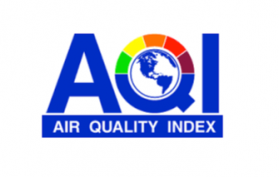
We’re all familiar with the weather forecast, but what about the air quality forecast? During the summer months, daily air quality forecast updates let the public know if it will be a green, yellow, orange or red air quality day – and each color means something different for our health. As the weather heats up and the risk for poor air quality accelerates, these forecasts can play an important role in helping individuals avoid the harmful effects of air pollution.
The colors represent values within the Air Quality Index (AQI), a numerical system that measures how clean or polluted the air is. The Environmental Protection Agency calculates the AQI for five major air pollutants as regulated by the Clean Air Act: ground-level ozone, particle pollution, carbon monoxide, sulfur dioxide and nitrogen dioxide. With values ranging from 0 to 500, the AQI determines health effects that may be experienced within hours or days after breathing polluted air. The higher the AQI value, the greater the level of air pollution and potential for concerns.
The AQI is divided into six categories, each corresponding to a different level of health concern. Symbolized by the color green, an AQI in the 0-50 range is considered “good,” and air pollution poses little to no health risk. When the AQI ranges from 51-100, the health concern level is “moderate” and symbolized by the color yellow. In this range, air quality conditions are acceptable; however, people who are unusually sensitive to ozone may experience respiratory symptoms.
When the AQI ranges from 101 to 150, air quality conditions are “unhealthy for sensitive groups” and symbolized by the color orange. People with lung disease, older adults and children are at a greater risk from exposure to ozone, while those with heart and lung disease, older adults and children are at greater risk from the presence of particles in the air. An AQI from 151 to 200 represents “unhealthy” air quality conditions and is symbolized by the color red. At this AQI, everyone may begin to experience some adverse health effects, and members of the sensitive groups may experience more serious effects. Any AQI from 201-500, is considered “very unhealthy” or “hazardous,” and can trigger negative health effects and health warnings for the entire population.
The health effects of poor air quality are numerous and can include shortness of breath, coughing, wheezing, headaches, nausea, eye and throat irritation and decreased lung function. Additional risks include aggravation of respiratory problems, asthma, allergies and lung diseases; impairment of the immune system, increased hospital and ER visits and irregular heartbeat, heart attacks and premature death in those with heart or lung disease.
To help keep the public updated on air quality conditions, the Clean Air Partnership posts the daily air quality forecast on our homepage. Residents can also visit the website to sign up to receive the forecast via email. Throughout the summer, the forecast can also be found on our Facebook page or by following the organization on Twitter @gatewaycleanair.
